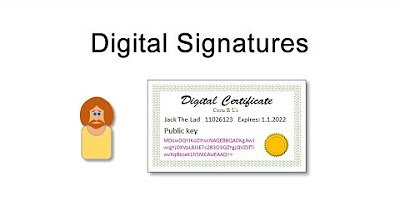Electronic signatures explained – Part 1: Electronic signature vs. digital signature | Signicat
Summary
TLDRThis video explains the concept of electronic signatures, which serve as a digital replacement for handwritten signatures. It discusses various forms of electronic signatures, such as signing on a screen or sending a text message, and their legal implications based on jurisdiction. The focus then shifts to digital signatures, a more advanced form that uses cryptographic methods to secure the document, ensuring protection from tampering. The process also involves user identification, which adds an extra layer of security and accountability in the signing process.
Takeaways
- 😀 An electronic signature replaces a handwritten signature with an electronic method.
- 😀 An electronic signature can include actions like scribbling a signature on a screen or sending an email or text message.
- 😀 The legality of electronic signatures may vary depending on the jurisdiction.
- 😀 Advanced electronic signatures require user identification as part of the signing process.
- 😀 A digital signature is a specific, secure implementation of an electronic signature.
- 😀 Digital signatures use cryptographic methods to protect the document from unauthorized changes.
- 😀 External changes to a document signed with a digital signature will be detected by the recipient.
- 😀 Digital signatures typically include identification of the signer to ensure accountability.
- 😀 Digital signatures are important for ensuring document integrity and verifying the identity of the signer.
- 😀 The use of cryptography in digital signatures prevents tampering and provides security for electronic transactions.
Q & A
What is an electronic signature?
-An electronic signature is any method used to replace a handwritten signature with electronic means. This can include writing your signature on a screen or sending an email or text message, depending on the jurisdiction.
How is an electronic signature used in various jurisdictions?
-In different jurisdictions, the definition and usage of electronic signatures can vary. In some cases, simply sending an email or text message may be sufficient, while other cases may require more advanced forms of electronic signatures.
What is the difference between an electronic signature and a digital signature?
-An electronic signature is a general term for any electronic means of replacing a handwritten signature, while a digital signature is a specific type of electronic signature that uses cryptographic methods to protect the document and prove the identity of the signer.
How does a digital signature enhance document security?
-A digital signature uses cryptographic techniques to ensure the document’s integrity. This means any changes made to the document after it has been signed will be detectable by the recipient.
What role does cryptography play in a digital signature?
-Cryptography in a digital signature ensures the security and integrity of the document. It prevents unauthorized changes and helps verify the identity of the signer.
Can a digital signature be used to identify the signer?
-Yes, a digital signature typically includes identification information about the signer, which helps verify who they are, adding an extra layer of security.
What happens if a document signed with a digital signature is altered after signing?
-If a document with a digital signature is altered after signing, the changes will be detected by the recipient due to the cryptographic protection.
Why is it important to prove the identity of the signer in the signature process?
-Proving the identity of the signer is crucial to ensure the authenticity of the signature and to prevent fraud or impersonation in the signing process.
What are some common methods of electronic signatures?
-Common methods of electronic signatures include signing on a screen, sending a signed document via email, or using more sophisticated authentication systems in advanced electronic signatures.
Are digital signatures legally recognized in all jurisdictions?
-Digital signatures are legally recognized in many jurisdictions, but the exact legal requirements and the level of recognition may vary depending on local laws and regulations.
Outlines

This section is available to paid users only. Please upgrade to access this part.
Upgrade NowMindmap

This section is available to paid users only. Please upgrade to access this part.
Upgrade NowKeywords

This section is available to paid users only. Please upgrade to access this part.
Upgrade NowHighlights

This section is available to paid users only. Please upgrade to access this part.
Upgrade NowTranscripts

This section is available to paid users only. Please upgrade to access this part.
Upgrade NowBrowse More Related Video

What is Document Signing? | Digital Signatures vs Electronic Signatures

Manfaat Tanda Tangan Digital hingga Cara Verifikasi Dokumen Elektronik

Non-repudiation - CompTIA Security+ SY0-701 - 1.2

3- CompTIA Security + SY0-701, CIA Triad

Digital Signatures and Digital Certificates

Privy MasterClass - Section 2: Dokumen Elektronik Sebagai Alat Bukti Di Pengadilan
5.0 / 5 (0 votes)